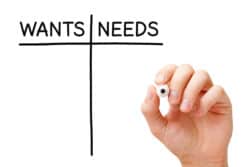Here are essential budget categories lists you could use when budgeting for the family.
Do you find yourself drowning in budget category lists sometimes?
If you are anything like me, budgeting for your family’s needs can be a royal pain. There’s always something someone needs, just like there’s always something someone wants but insists they absolutely need.
I often find myself being the bad guy and turning down requests from otherwise reasonable and lovable family members who don’t understand that Mommy’s bank account isn’t an endless pit.
Today, let me share my sample essential budget categories list highlighting what should be included in each category. Keep reading for a breakdown of critical budget categories and their priority items.
Also see: 10 Must-Know Personal Finance Tips for Mom’s Financial Success
Basic Family Budget Categories
Family budget item lists typically fall under the following three broad categories, giving them priority status.
Needs, Essentials, or Regular Expenses
These are a combination of basic human needs you must have to survive and payments that have to be done monthly to keep things running.
Under this list, you will find food; utilities like water, gas, or heating; transportation costs; debts like personal loans and credit card bills; and essential insurance premiums.
Wants, Discretionary, or Irregular Expenses
These items complement essential expenses, making life easier and more enjoyable. Things you love as a family but you can survive without, as hard as it may seem. Once you allocate a portion of your budget to them, you can arrange them in order of priority and start with what you need most.
You can reduce the quantities if your disposable income falls short, and you don’t have to get the same item each month, ergo irregular expenses. This category covers entertainment, clothing, hobbies, holidays, and gadgets like smartphones.
Savings and Investments
This is the easiest category to overlook among family budget items as it offers no instant gratification. However, it is the surest guarantee that you will retain your spending power to keep taking care of your family into the future.
You will enjoy reducing the deficit once there is a solid savings goal. It pays to have the capital to participate when investment opportunities come up.
A Comprehensive Budget Categories List for the Household
I find it easier to prioritize items when I use my own personal budget categories. This way, you can isolate items important to you from a general grouping and create a custom priority list that gives more value for your money. Here are my categories.
Housing
Housing takes the largest chunk of the essentials in any budget; it averages 30% of the entire budget, depending on household income and debt. This can be attributed to the large number of expenses under the housing category and its high demand.
Besides mortgage repayments or rent, other home expenses to factor in are property taxes, home repairs, other household products, pest control, homeowner’s or renter’s insurance, home warranties and protection plans, and HOA dues.
Food
This is another basic human need of a higher priority because your family needs to eat every day. The budget should cover what you eat at home and outside the house. It includes groceries, snacks, bills from eating out, and takeout.
The USDA estimates that the average budget share for food per family was 10.3%, distributed almost equally between food at home and food away from home. These figures should help you formulate your own budget.
Transportation
Transportation expenses include car payments, gas, parking fees, car maintenance, DMV fees, license fees, taxes, and car insurance if you use your own car. It can also be bike maintenance and repair if you are a rider, or rideshare services, taxi costs, car rental fees. or bus fare for those using public means.
Also See: How to Save Up for a Car Without Breaking the Bank
Utilities
These are important expenses as they cover essential services that keep the household running. Bills like electricity, water, heating, cable or streaming services, internet, and phone bills. Depending on your location and the house size, they will range from 5 to 10% of your budget.
Savings and Investments
Preparing for the future involves setting financial goals based on where you want to be. I am sure you want your kids to grow up in a financially stable environment. Motivations for saving for your family are diverse.
It can be an emergency fund, a deposit to buy a house or pay off a mortgage, money to pay off debts, investments in other business ventures, college saving plans for your kids, or retirement contributions.
There are many saving options that can help you reach your target faster. Here are just a few examples of many opportunities your savings can open up for you.
- High-interest savings accounts let you earn money from your savings.
- Certificates of deposit (CDs) pay higher interest than the current market rate after the agreed period despite prevailing market conditions.
- Individual retirement accounts (IRAs) are tax-advantaged and reduce your tax burden on current earnings.
Healthcare
You need to be in a position to cover doctor bills, hospital bills, the cost of medicines and prescriptions, first aid supplies, glasses or contacts, or any medical devices that members of your household might need.
Your best bet is to get health Insurance coverage for all your loved ones, as it’s impractical to estimate the future cost of treatment.
Periodic Expenses
This budgeting category covers easily forgotten expenses because they don’t occur monthly, sometimes not even regularly. They can be regular or irregular expenses, depending on the payment type. I use this category to budget for gifts for anniversaries, graduations, birthdays, and other special occasions that come up.
I used to forget about them until the last minute then I discovered that factoring a portion of them into my monthly budget ensured there was money in the account when it was time. You can use this category for yearly and quarterly bills or donations to charity.
Miscellaneous Expenses
This is largely an unexpected expense category to cover irregular expenses that come up during the budget period.
When you have a fixed income and fixed expenses, there are chances that the funds allocated under the miscellaneous expense category will remain unutilized. Use the extra money at the end of the month to get ahead of your debt or beef up your savings. I stash mine in an emergency fund that I keep for expensive times of the year, like when the kids are on holiday.
Necessities Versus Wants
I find Maslow’s hierarchy of needs useful whenever I feel like I’m developing a spending habit. It defines our needs from basic to complex.
My first priority is always my household’s basic human needs, the physiological ones without which we can’t survive. These are food, water, sleep, shelter, and clothing. They will feature in every family budget. In households that are really struggling to make ends meet, they end up being the only budgeted items that are actually provided for.
Then I consider security and stability—guaranteeing that we can sustain our lifestyle through irregular income phases and other unforeseeable changes in circumstances. A part of this is derived from the community and social network built over the years. It is also where emergency savings and insurance come into play.
Then there is the need for self-actualization and esteem gained from personal growth and achievements. You make provisions to go back to school, get another certification, or learn a skill that will boost your job security or increase your earning potential. This is also where you set financial goals for your savings beyond survival and make purposeful investments.
However, the line between needs and wants can be blurry as disposable income increases. Many discretionary expenses are camouflaged as necessities because they are used on items categorized as needs. This can be a major obstacle to optimizing your income as it prevents you from allocating funds to other purposeful categories.
For example, the more frequently you eat out, the higher the family’s budget expenditure on food. We all know that family that moved into a larger house than they needed because it was a nice neighborhood, without factoring in the related HVAC bills and other expenses. While shelter is a basic need, a significant portion of their housing expense can be classified as discretionary.
This is why assigning family budget categories percentages is recommended. I allocate 50% of my income to needs, 30% to wants and 20% to debt repayment and savings (debts are a part of investment in my book).
Budgeting Using a Budget Categories List
After identifying categories relevant to your household budget, you need to separate the funds and allocate them to their respective segment.
My mom used to have an elaborate envelope system that she would use to separate cash meant for different purposes. This still works in my house for petty cash, but I hardly handle physical bills anymore, so I adopted a budget spreadsheet where I list my needs in order of priority in different categories. I update the list every time I buy something from it.
I’m considering moving to online budgeting tools like a budgeting app. They make accounting easier as the records are easily accessible at the touch of a button, and you can update the budget in real-time.
Feel free to customize your categories to suit your goals and lifestyle as you create your budget. By now, you must have identified areas that will impact your budgeting method most.


